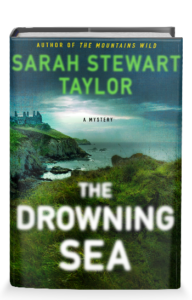 The third novel in Sarah Stewart Taylor’s Maggie D’Arcy series finds Maggie at a crossroads. Formerly a Long Island cop, she’s now unemployed, and in Ireland with her daughter, on holiday with her boyfriend, Connor and his son. The first novel was Maggie’s journey backwards: she looked for the killer of her cousin, who had disappeared in Ireland twenty years before. The second novel finds her investigating a crime that begins on a Long Island beach but has roots in Ireland. This third novel finds her firmly in Ireland, planning to move there, and deciding what she should do as far as a new career. As the book makes obvious, she very much misses police work and hates being on the outside looking in (this is a clue to her eventual decision, but it’s hardly a spoiler).
The third novel in Sarah Stewart Taylor’s Maggie D’Arcy series finds Maggie at a crossroads. Formerly a Long Island cop, she’s now unemployed, and in Ireland with her daughter, on holiday with her boyfriend, Connor and his son. The first novel was Maggie’s journey backwards: she looked for the killer of her cousin, who had disappeared in Ireland twenty years before. The second novel finds her investigating a crime that begins on a Long Island beach but has roots in Ireland. This third novel finds her firmly in Ireland, planning to move there, and deciding what she should do as far as a new career. As the book makes obvious, she very much misses police work and hates being on the outside looking in (this is a clue to her eventual decision, but it’s hardly a spoiler).
More than anything else, these novels are a love letter to Ireland. While the first two had more of a city focus, this one is out in the country, by the water, where Maggie finds a great deal of solace in running and in early morning swims in the very cold sea. The atmosphere, the detail of the landscape – Stewart Taylor takes her reader there. This book also boasts a nice, haunted, gothic, creepy mansion at the center of it all.
The little village where Maggie and Connor are spending their holiday is centered around this old mansion, the “Big House” of past days, where many of the villagers worked and where one of them, Lissa, lived as a girl. She has sold the family home to developers and lives in a cottage where she paints and where she has a bird’s eye view of her former family home.
Added into this mix is a scattering of Polish workers, in town to work the construction jobs springing up as the old house is developed into a hotel and as fancier cottages are being built. The natives are split on whether development is good or bad – I kept flashing back to the 80’s film, Local Hero, where one of the characters, talking about proposed development in a tiny, picturesque Scottish town, says “You can’t eat scenery.” Obviously, there’s a case for each side.
Then there is the unexplained body that washes up on the beach, the body of a young Polish man who has disappeared several months in the past. Maggie is drawn to the mystery not only because that was her job, but because the dead man is connected to the young man her teenage daughter is now dating. She’s interested in the connections.
This novel is very much about connections as Maggie is appreciating her connection with Connor; figuring out her changing connection to her teenager, Lilly; the connections she might be able to form in her possible new Irish home, and whether they will be as resonant as the long-established ones she had home in Long Island. She’s homesick, but she’s also looking forward. The book makes a case for community, for family connection, and ultimately, for connection to nature. The gentle mystery is an integral part of this beautifully written story, but it’s only a part. True to form, Stewart Taylor wraps things up with a bang. I felt like I’d been to Ireland after I closed the book, and I very much enjoyed the journey. I’m looking forward to seeing how Maggie’s next life decisions play out.